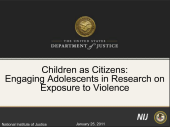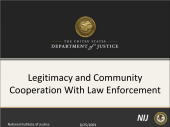Research for the Real World: NIJ Seminar Series
NIJ's in-person seminar series is held periodically in Washington, D.C., and features research that is changing our thinking about policies and practices. The seminars are recorded before a live audience and published on the NIJ Web.
Upcoming Seminar
We have not yet scheduled our next seminar.
Past Seminars
| Title and Date | Link to Media |
|---|---|
| Changing the Behavior of Drug-Involved Offenders: Supervision That Works NIJ Research for the Real World Seminar December 2012 Angela Hawken, Ph.D., Associate Professor of Economics and Policy Analysis, Pepperdine University, and Mark Kleiman, Ph.D.Professor of Public Policy, University of California, Los Angeles A small number of offenders who are heavily involved in drugs commit a large portion of the crime in this country. An evaluation of a "smart supervision" effort in Hawaii that uses swift and certain sanctioning showed that heavily involved drug offenders can indeed change their behavior when the supervision is properly implemented. Drs. Angela Hawken and Mark Kleiman evaluated Hawaii's swift and certain supervision program, more commonly referred to as Hawaii HOPE. They will discuss what they learned and how the principles of HOPE are being applied elsewhere. They will discuss, for example, the kinds of offenders who are now being supervised under HOPE-style programs in Hawaii and on the mainland. They will also discuss the important unanswered research questions, such as: the psychological mechanisms that underlie the dramatic behavior changes, the minimum effective sanction, whether sanctions should escalate, and when revocation is appropriate. They also will discuss the wider implications for juveniles, alcoholics, pretrial releases and prisoners, as well as the appropriate role of the federal government. |
Recording forthcoming |
| Title and Date | Link to Media |
| The Neurobiology of Sexual Assault: Implications for First Responders in Law Enforcement, Prosecution, and Victim Advocacy NIJ Research for the Real World Seminar December 2012 Rebecca Campbell, Ph.D., Professor of Psychology, Michigan State University Dr. Campbell brings together research on the neurobiology of trauma and the criminal justice response to sexual assault. She explains the underlying neurobiology of traumatic events, its emotional and physical manifestation, and how these processes can impact the investigation and prosecution of sexual assaults. Real-world, practical implications are examined for first responders, such as law enforcement, nurses, prosecutors, and advocates. We also recorded a 3-part interview with Dr. Campbell. |
 Watch the seminar Transcript of the seminar Video of the interview (14:43) Transcript of the interview |
| Reforming New Orleans' Criminal Justice System: The Role of Data and Research NIJ Research for the Real World Seminar September 2012 Michael Jacobson, Ph.D., President and Director Vera Institute of Justice With its criminal justice system in disarray following Hurricane Katrina, New Orleans invited the Vera Institute of Justice to examine the city's court and jail operations. For five years, Vera has been tracking arrest-to-first-appearance time, custodial arrests versus summonses, the granting of pretrial release, and many other decision-making points. Based on analysis of these data, Vera is making policy recommendations to assist with the implementation of new procedures and to ensure performance monitoring. Like other jurisdictions, New Orleans had never collected court, jail, and other justice system data in ways that could inform policy development. Vera's work has demonstrated to key stakeholders that data capture and analysis can be critical. Learn more about these successes, the continuing challenges of replacing a jurisdiction's existing data systems, and how costs and other institutional issues will test the "acceptance" of critical criminal justice policies in the years to come. NIJ also recorded an interview with Dr. Jacobson in which he addressed the following questions:
|
Listen to the seminar (01:22:08) Transcript of the seminar Watch the interview (4 segments) Transcript of the interview |
| Violent Repeat Victimization: Prospects and Challenges for Research and Practice NIJ Research for the Real World Seminar April 2012 Janet L. Lauritsen, Professor of Criminology and Criminal Justice, University of Missouri-St. Louis Research tells us that a relatively small fraction of individuals experience a large proportion of violent victimizations. Thus, focusing on reducing repeat victimization might have a large impact on total rates of violence. However, research also tells us that most violent crime victims do not experience more than one incident during a six-month or one-year time period. As a result, special policies to prevent repeat violence may not be cost-effective for most victims. Dr. Lauritsen summarizes existing research on repeat violent victimization, both here in the United States and abroad. She provides new findings from the National Crime Victimization Survey about the potential impact that reducing repeat victimization might have on rates of violence in the U.S. She discusses possible factors that can be used to predict whether victimization is likely to be repeated and suggest how such information can inform policy and practice. She also discusses several factors, such as persistent exposure to offenders, that appear to be unique to repeat victimization and most relevant to developing effective policies and practices. We also captured an interview with Dr. Lauritsen in which she discusses in three short segments:
|
 Presentation (1:25:18) Transcript of the presentation Interview with Janet Lauritsen (3 segments) Transcript of the interview |
|
Addiction, the Brain, and Evidence-Based Treatment
|
 Presentation (01:22:20) Transcript of the presentation Interview with Redonna K. Chandler (3 segments) Transcript of the interview |
| Economical Crime Control: Perspectives from Both Sides of the Ledger NIJ Research for the Real World Seminar December 2011 Phillip J. Cook, ITT/Sanford Professor of Public Policy, Professor of Economics and Sociology, Duke University The surge in incarceration since 1980 has been fueled in part by the mistaken belief that the population can be divided neatly into "good guys" and "bad guys." In fact, crime rates are not determined by the number of at-large criminals, any more than farm production is determined by the number of farmers. Crime is a choice, a choice that is influenced by available opportunities as much as by character. This perspective, drawn from economic theory, supports a multi-faceted approach to crime control. Dr. Cook's presentation includes examples of effective programs and policies from both sides of the ledger — both people-changing, and opportunity-changing. We were also able to capture an interview Dr. Cook in which he discusses in three short segments:
|
 Presentation (1:09:03) Transcript of the presentation Interview with Phillip Cook (3 segments) Transcript of the interview |
| Going Home (or Not): How Residential Change Might Help Former Offenders Stay Out of Prison Dr. David Kirk, Assistant Professor, University of Texas at Austin October 2011 Dr. Kirk discusses how Hurricane Katrina affected ex-prisoners originally from New Orleans and their likelihood of returning to prison. Kirk also discussed potential strategies for fostering residential change among ex-prisoners, focusing specifically on parole residency policies and the provision of public housing vouchers. We were also able to capture an interview Dr. Kirk in which he discusses in two short segments:
|
 Presentation (1:25:31) Transcript of the presentation Interview with David Kirk (2 segments) Transcript of the interview |
| Try Again, Fail Again, Fail Better: Lessons from Community Courts Greg Berman, Director, Center for Court Innovation April 21, 2011 Change doesn't come easy, particularly within an institution as large and complex as the criminal justice system. Greg Berman, Director of the Center for Court Innovation, offered lessons from several efforts to make reform stick in criminal justice settings. In particular, he focused on the development of community courts — experimental court projects that are attempting to reduce both crime and incarceration in dozens of cities across the U.S. and around the world. He also drew upon his recently-published book Trial & Error in Criminal Justice Reform: Learning from Failure (Urban Institute Press). |
 Presentation (1:12:36) Transcript of the presentation Interview with Greg Berman (4 segments) Transcript of the interview |
| Benefit-Cost Analysis for Crime Policy Ms. Roseanna Ander, Executive Director, University of Chicago Crime Lab and Dr. Jens Ludwig, Director, University of Chicago Crime Lab February 24, 2011 How do we decide how to allocate criminal justice resources in a way that minimizes the social harms from both crime and policy efforts to control crime? How, for that matter, do we decide how much to spend on the criminal justice system and crime control generally, versus other pressing needs? These questions are at the heart of benefit-cost analysis. Benefit-cost analyses begin with the crucial and often under-appreciated first step of successfully identifying the impact of a policy or program. Jens Ludwig and Roseanna Ander will explain the different options for identifying policy and program impacts, and discuss the challenges of attempts to monetize costs and benefits. For example, some of the most important costs and benefits of crime control efforts come from intangible aspects of well-being for which dollar values are not easily attached. |
 Presentation (1:19:41) Transcript of the presentation Interview with Jens Ludwig (2 segments) Transcript of the interview |
| Children as Citizens: Engaging Adolescents in Research on Exposure to Violence Dr. Felton Earls, Professor, Harvard University January 25, 2011 Since the adoption of the United Nations Convention on the Rights of the Child in 1989, great strides have been made in the areas of child protection and advocacy. However, the concept of children, and specifically adolescents, as functional and engaged citizens has also emerged. Through the guidance and recognition of adults, children can participate in deliberative democracy as legitimate and competent citizens. This citizenship, like that of adults, can be used to enrich and improve local communities by creating a sense of ownership and fairness. Dr. Earls presented research on child participation, child citizenship and their relationship to exposure to violence. The theories and practices guiding this research originated in the Project on Human Development in Chicago Neighborhoods and have continued to evolve in different settings around the world. Dr. Earls was the Special Editor of the January 2011 ANNALS of the American Academy of Political and Social Science Exit Notice, which focuses on conceptual, legal, and practical issues related to the realization of children as citizens. |
 Presentation (1:13:13) Transcript of the presentation Interview (4 segments) Transcript of the interview |
|
Don't Jump the Shark: Understanding Deterrence and Legitimacy in the Architecture of Law Enforcement |
 Presentation (1:23:38) Transcript of the presentation Interview (6 segments) Transcript of Interview |
|
Mothers and Children Seeking Safety in the U.S.: A Study of International Child Abduction Cases Involving Domestic Violence |
 Presentation (1:23:22) Transcript of the presentation |
|
Police-on-Police Shootings and the Puzzle of Unconscious Racial Bias |
 Presentation (1:11:57) Transcript of the presentation |
| Solutions in Corrections: Using Evidence-based Knowledge Dr. Edward Latessa, University of Cincinnati May 13, 2010 Professor Ed Latessa describes how his team and he assessed more than 550 programs and saw the best and the worst. Professor Latessa shared his lessons learned and examples of states that are trying to use evidence-based knowledge to improve correctional programs. |
 Presentation (1:17:17) Transcript of the presentation Interview (15:21) |
| Less Prison, More Police, Less Crime: How Criminology Can Save the States from Bankruptcy Dr. Lawrence Sherman, University of Pennsylvania April 21, 2010 Professor Lawrence Sherman explains how policing can prevent far more crimes than prison per dollar spent. His analysis of the cost-effectiveness of prison compared to policing suggests that states can cut their total budgets for justice and reduce crime by reallocating their spending on crime: less prison, more police. |
 Presentation (49:49) Transcript of the presentation Interview (16:48) Transcript of the interview |
| Nurse-Family Partnerships: From Trials to International Replication Dr. David Olds, University of Colorado Jan. 20, 2010 David Olds, founder of the Nurse-Family Partnership Program, describes the programs long-term impact on mothers and babies who began participating in the program more than 19 years ago. The Nurse-Family Partnership maternal health program introduces vulnerable first-time parents to maternal and child health nurses. It allows nurses to deliver the support first-time moms need to have a healthy pregnancy, become knowledgeable and responsible parents, and provide their babies and later children and young adults with the best possible start in life. |
 Presentation (55:35) Transcript of the presentation Interview (3:16) |
| From the Academy to Retirement: A Journey Through the Policing Lifecycle Dr. Dennis Rosenbaum, Professor of Criminal Justice and Psychology at University of Illinois at Chicago Dec. 11, 2009 Professor Rosenbaum and a panel of colleagues discuss a study to demonstrate the feasibility of creating a foundation from which to launch studies about multiple aspects of policing using standardized definitions and measurement tools. Their goal is to advance knowledge about policing and translate data into evidence-based best practices that improve training, supervision and accountability systems. The effort is expected to produce a better understanding of what motivates police officers and makes them healthier, happier and more effective. |
 Presentation (1:00:14) Transcript of the presentation Learn more on the Web topic page Foundation for Policing Research |
| Crime Mapping and Hot Spots Policing Dr. David Weisburd, Distinguished Professor of Administration of Justice at George Mason University Oct. 26, 2009 David Weisburd, recipient of the 2010 Stockholm Prize in Criminology, explains research showing that intensified police patrols in high-crime hot spots can substantially decrease crime without causing it to rise in other areas. He explains the effectiveness of policing that concentrates prevention efforts at less than 5 percent of all street corners and addresses where more than 50 percent of urban crime occurs. The evidence suggests that crimes depend not just on criminals, but also on policing in key places. |
 Interview (1:10:27) Transcript Learn more on the hot spots Web topic page. |
| Legitimacy and Community Cooperation With Law Enforcement Dr. Tom R. Tyler, New York University Aug. 25, 2009 Tom R. Tyler, chair of the New York University psychology department, describes research on profiling and community policing. His research found that citizens of all races show greater respect for law enforcement when they believe officers are treating them fairly. Even citizens who experienced a negative outcome getting a traffic ticket, for example showed higher levels of respect for and cooperation with law enforcement as long as they believed they were not being singled out unfairly. |
 Presentation (1:23:13) Transcript of the presentation |
| Men Who Murder Their Families: What the Research Tells Us Dr. Jackie Campbell, Johns Hopkins University Dr. Richard Gelles, University of Pennsylvania, David Adams, author of Why Do They Kill? Men Who Murder Their Intimate Partners June 2, 2009 Experts discuss cases of domestic violence that escalate to homicide followed by suicide. Although the economy and unemployment are risk factors, prior domestic violence is by far the number one risk factor. The men usually display possessive, obsessive and jealous behavior, and they typically use guns to threaten and terrorize before they use them to kill. |
 Presentation (1:30:08) Transcript Learn more about intimate partner violence on the Web topic page |


